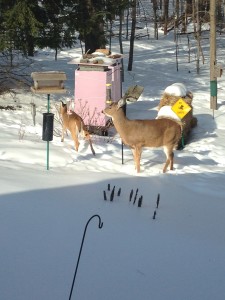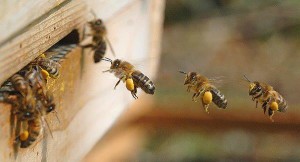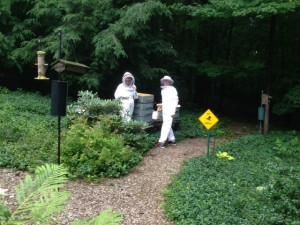by Patricia Grupp
Editor’s Note: The following was written by Kalamazoo Bee Club member Patricia Grupp; I’m only posting it for her. Thanks Pat, for sharing your observations and experience. CH
Here’s a few of my observations of beekeeping in Michigan. I have been questioning some of the practices I observe and think they contribute to yearly losses. These practices are:
 1- Feeding sugar solutions: The latest nutritional standards direct each of us to greatly reduced sugar intake. Maybe it is also important for our bees to not have sugar. How can healthy bees be maintained with a good immune system on a diet of sugar? If it is bad for us; it must be worse for our bees. No, honey is not just another sugar but a healthy food source.
1- Feeding sugar solutions: The latest nutritional standards direct each of us to greatly reduced sugar intake. Maybe it is also important for our bees to not have sugar. How can healthy bees be maintained with a good immune system on a diet of sugar? If it is bad for us; it must be worse for our bees. No, honey is not just another sugar but a healthy food source.
Sugar comes from sugar cane, sugar beets or corn in the form of high fructose corn syrup. The August 2012 article “Testing of Bee Feed Syrups for Neonicotinoid Residues”, in the American Bee Journal, states that in recent years growers are using neoniconoids on sugar beets, sugar cane and corn. Knowing that this is a systemic product or transported in the tissues of the plant, could residues be ingested by our bees, affecting bees health and immune systems? The article’s conclusion is that no residues were detected at allowable levels.
Are these “allowable levels” known? Could these “allowable levels” accumulate in bees sustained on sugar?
I know I do all I can to stay away from products made from sugar and corn and I want my bees to also. I feed honey only.
 2- Little to no insulation used on most Michigan hives to prepare for winter: No bee colony would chose a box, tree, etc. that was 3/4 inch thick, the thickness of a Langstroth box. Black tar paper used for insulation has to be of little effect. Where did that idea come from? It has no ‘R’ rating or insulating factor.
2- Little to no insulation used on most Michigan hives to prepare for winter: No bee colony would chose a box, tree, etc. that was 3/4 inch thick, the thickness of a Langstroth box. Black tar paper used for insulation has to be of little effect. Where did that idea come from? It has no ‘R’ rating or insulating factor.
I have used light-weight, foam insulation either year around or just for winter. Depending on the thickness of the foam the insulation factor can be known. This adds an insulation of significance without adding weight.
I would think bees eat less honey if insulated because they need less energy to keep warm. If they use less energy to keep warm, they produce less heat and moisture, minimizing the moisture problem. And they must be stressed far less if kept in an insulated hive where they don’t have to work as hard to keep her majesty warm.
 3- Use of chemicals to kill pests, especially varroa mites: I detect the thinking now in Michigan is to get away from chemicals. I don’t want to ultimately ingest chemicals in my harvested honey. What are these chemicals doing to generations of bees? To have survived for thousands of years bees need to produce the next genetic buffer to protect themselves. It was said that it would take generations after generations for bees to learn to deal with varroa. Not true! We are already seeing bees limiting mites. Leave them alone! Don’t use chemicals to allow the next generation of bees to strengthen this ability. My policy is, if my bees die from varroa, let them die. I’ll look for a strain of bees that can handle varroa–not artificially eliminate the pest with chemicals that have unknown toxicity.
3- Use of chemicals to kill pests, especially varroa mites: I detect the thinking now in Michigan is to get away from chemicals. I don’t want to ultimately ingest chemicals in my harvested honey. What are these chemicals doing to generations of bees? To have survived for thousands of years bees need to produce the next genetic buffer to protect themselves. It was said that it would take generations after generations for bees to learn to deal with varroa. Not true! We are already seeing bees limiting mites. Leave them alone! Don’t use chemicals to allow the next generation of bees to strengthen this ability. My policy is, if my bees die from varroa, let them die. I’ll look for a strain of bees that can handle varroa–not artificially eliminate the pest with chemicals that have unknown toxicity.
4- Buying southern bees: I hear of more and more of the effort to buy northern bees. Let’s buy from each other and spread around good genes … genes that tackle winter, varroa, etc.
5- Frequent, invasive hive checks: I just started with a horizontal hive. One among many reasons why I love horizontal hives is the less invasive hive checks. And how often do we really need to tear open a hive? Sometimes some good observation and adding a box or a few frames is all that is necessary. Why check for mites? I am not going to use chemicals anyway.
 6- Having agriculture nearby: I live where agricultural is not close by. My bees have plenty of forage without seeking out a corn field. That’s my good fortune. I didn’t plan it that way. This reduces exposure to even more chemicals.
6- Having agriculture nearby: I live where agricultural is not close by. My bees have plenty of forage without seeking out a corn field. That’s my good fortune. I didn’t plan it that way. This reduces exposure to even more chemicals.
7- Not leaving enough food, (honey): The only time I lost bees was the cold winter of 2013-14. They survived the winter but died mid-March from starvation. I couldn’t reach them in thigh-deep snow and it was too cold to open the hive to add honey frames if I could reach them. Mid-March (they were alive before that) found them dead at the top of the hives after having eaten a vertical tunnel through all boxes of honey.
That fall I left them a brood box and four mediums of honey. Now I leave them a brood box and five mediums of honey. I can’t reach any higher. That’s it girls! (And I extracted over 215 pounds of honey from two boxes before I prepared them for winter.)
I frequently see bees ready for winter with two boxes of honey. Is that enough to last the winter in Michigan? Not from my experience. No wonder bees are dead by January!
These are some of my thoughts. As we all know beekeepers have a variety of ideas and methods of handling bees. I’m still learning and 10 years from now I will still be learning. That is what makes beekeeping so exciting, never boring. I am glad to be a part of a community of beekeepers from whom to learn.
Great points. I’ve lost one hive so far. Slid in the new and improved pollen packet in my other. Upon opening my dead hive, bees died head first in the comb. Yet there was honey. I left the front door open, with the mouse guard in place for my other hive.
I have a question I live in Redding California and today I was setting outside watching the bee’s do there hard work and I seen a black flying bug that was big in size it was not a bumble bee but it was being very aggressive towards the honey Bee’s and it was trying to run them off the honey bee’s would run but they would come right back and try to pollinate .it seemed to just go after the flying Honey bee’s . I have never seen this before have u heard of this ?
Thanks Larry
For anyone interested in information on whether this is collaborated by experts, or not, refer to the January “American Bee Journal” article entitled “Surviving Without Treatments: Lessons from Wild Bees”. It is an interview of Dr. Thomas Seeley, researcher and faculty at Cornell University and also author of “Honeybee Democracy” among other books, by Dr. Leo Sharaskin. Dr. Sharaskin is author of “Keeping Bees with a Smile” and his website address is: http://www.HorizontalHive.com.
Sorry, two corrections to my post. The article in the “American Bee Journal” is actually in the February 2016 issue, and Dr. Sharaskin edited the book, “Keeping Bees With a Smile”, he was not the author.
Thanks for your reply.
To those who say I spread varroa to other bees because I do not treat with chemicals, I say and you are not allowing the bees to find their own solution. This “solution” is already being seen in bees that are biting off the legs of varroa, “ankle bitters”.
Forget chemical Shares!
Thanks for the article recommendation.
Opps! I meant I collected 215 pounds from two hives, not two boxes.
Pat
Beekeeper, and World War II veteran, is at risk of losing his beehives he s had since the 19.